 |
Propodeal spines long and
(mostly) relatively blunt
apically |
-- |
Hypostomal teeth
((non-type)
|
| . |
pulchella group species
as listed by Fischer, Hita Garcia & Peters (2012)
batrachorum, christinae (minors only), darwini, dea, glabrella, heliosa, nimba (minors only), pulchella, rebeccae, semidea and setosa
(minor only)
|
. |
|
| F 1A |
Minor
and major: colour
yellow to orange |
F 2 |
|
| F 1B |
Minor and major colour
light, reddish brown to very dark brown, sometimes black |
F 4 |
|
| F
2A |
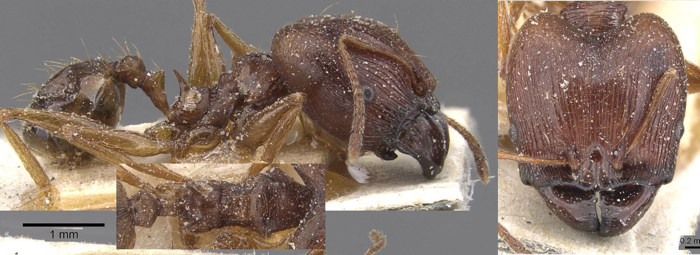
TL 5.0-5.5 mm, HL 2.11,
HW
2.11, SL 1.23, PW 0.80; CI 100, SI 61; antennal scrobe
conspicuous; sides of head without laterally
projecting hairs in full-face view
propodeal spines long and distinctly down
curved in profile; overall rich ferruginous red; clypeus and borders of
mandibles black; legs and antennae paler and more yellowish red |
. |
|
| . |

Minor:
HL 0.90, HW 0.77, SL 1.19, PW 0.51; head evenly rounded at sides and
posterior margin; head relatively
shorter (CI 82–90); pilosity on scape and metatibia decumbent
|
Congo
Basin - pulchella |
|
| F 2B |
Major (of P. heliosa; major
of P. christinae unknown):
antennal scrobe absent or inconspicuous; head in full-face view with
laterally projecting hairs
|
F 3 |
|
| F 3A |
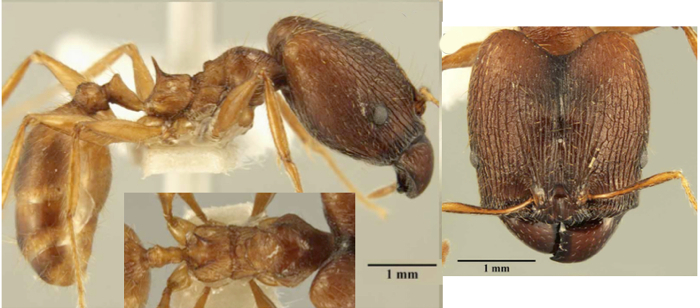
Major:
HL 2.45, HW 2.35, SL 1.24, PW 1.07; CI 96, SI 53;
head without
antennal scrobe; in full-face view hairs projecting
beyond lateral margin. |
.
|
|
| . |

HL 1.07, HW
0.80, SL 1,35, PW 0.59; head,
scapes and legs very long (CI 73–76, SI 162–174, FI 206–213); occipital
carina broadly extended and collar-like; standing hairs acute and very
abundant, present also on lower meso- and metapleuron,
visible in dorsal view |
Cameroon,
Ivory Coast - heliosa |
|
| F
3B |
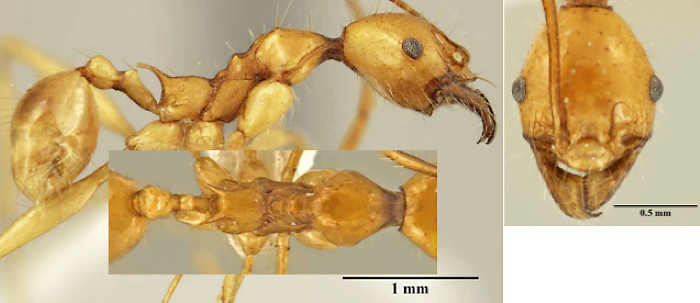
Major
unknown
HL 0.98, HW 0.80, SL 1.24, PW 0.54; head, scape and legs relatively
shorter (CI 79–84, SI 143–164, FI 175–198); occipital carina narrow,
not collar-like; standing hairs often apically truncated or split,
generally less abundant, absent on lower meso- and metapleuron
|
D.R.
Congo, Gabon, Uganda - christinae |
|
| F 4A |
Major:
either
posterolateral lobes partly smooth and shiny and scape
with erect hairs in addition to decumbent pilosity or
posterolateral lobes uniformly punctate with weak rugulae and posterior
dorsopropodeum with oblique to longitudinal rugulae
Minor: head with several relatively long, laterally projecting hairs
posterior of eye-level
|
F 5 |
|
| F 4B |
Major: head sculpture
various; scape never with several erect hairs in
addition to appressed or decumbent pilosity; sculpture on
posterior dorsopropodeum transversely rugulose, punctate or smooth, and
never with oblique or longitudinal rugulae
Minor: head completely without or at most with one or two moderately
long projecting hairs near eyes or towards posterior margin
|
F 7 |
|
| F 5A |
Major:
posterolateral
lobes partly smooth and shiny and scape with
erect hairs in addition to decumbent pilosity, or posterolateral lobes
uniformly punctate with weak rugulae and posterior dorsopropodeum with
oblique to longitudinal rugulae. (Major of P. setosa unknown)
Minor: head shape elliptical (CI 79–89); posterior margin relatively
narrow and evenly convex; occipital carina with weak median impression;
scapes moderately long (SI: 139–172), with pilosity uniformly suberect
or decumbent
|
F 6 |
|
| F 5B |

Major unknown
Minor - HL 0.86, HW 0.75, SL 1.08, PW 0.49; head shape broadly rounded,
posterior margin not evenly convex (CI: 87–90); occipital carina
without median impression; scapes relatively shorter (SI: 129–135);
scape pilosity decumbent with additional suberect hairs on outer edge
|
D R
Congo - setosa |
|
| F
6A |
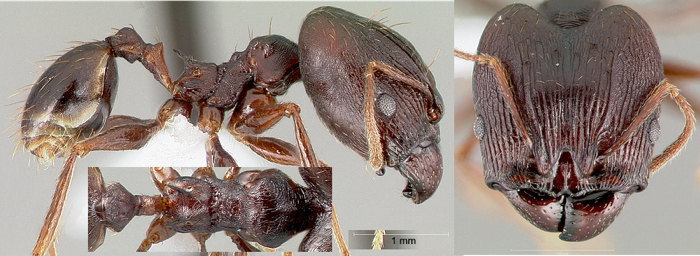
Major: HL 1.89, HW 1.86, SL 1.05, PW 0.82; CI 99, SI 57;
posterolateral
lobes uniformly punctate with some weak rugulae;
scape with uniformly appressed to decumbent pilosity; posterior
dorsopropodeum with oblique to longitudinal rugulae |
. |
|
| , |
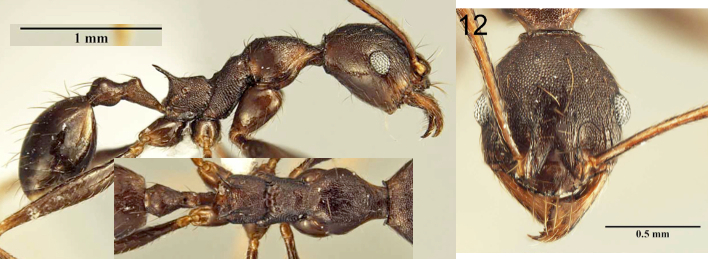
HL 0.82,
HW 0.68, SL 1.09, PW 0.47; head
relatively narrow (CI 79–86); scapes long (SI 153–172); scape pilosity
uniformly decumbent; face almost completely and distinctly punctate |
Congo
Basin - batrachorum |
|
F 6B
|
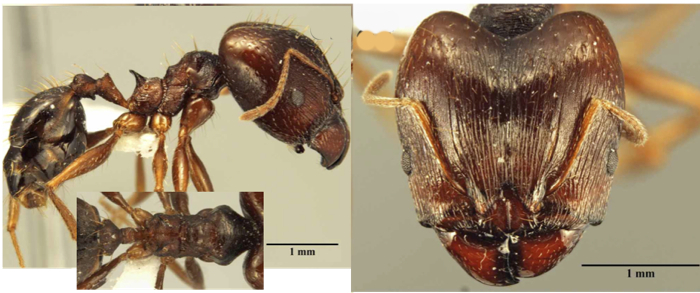
Major:
HL 2.10, HW 2.12, SL 1.06, PW 0.93; CI 101, SI 50; posterolateral
lobes partly smooth and shiny; scape with some
erect hairs additional to decumbent pilosity; posterior dorsopropodeum
weakly to superficially rugulose-punctate |
. |
|
| . |

HL 0.84, HW
0.72, SL 1.08, PW 0.48; head
relatively wider (CI 84–89); scapes slightly shorter (SI 139–160);
scape pilosity uniformly subdecumbent to suberect; face smooth and
shiny, hexagonally microsculptured to very faintly punctate |
Congo
Basin - darwini |
| F 7A |
Major:
head sculpture
variable, but never distinctly punctate on frons, vertex and
posterolateral lobes; gaster never entirely shagreened.
Minor: head longer than wide (CI 85–95), posterior margin roundly or
slightly convex; scapes and mandibles moderately long (SI 123–150, MDI
72–79).
|
F 8 |
|
| F 7B |
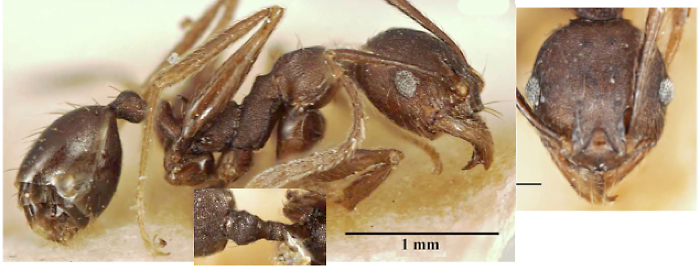
Major
unknown
Minor - HL 0.86, HW 0.77, SL 0.99, PW 0.52; head and alitrunk almost
completely and coarsely punctate
|
Guinea
- nimba |
|
| F 8A |
Major:
posterolateral
lobes variably sculptured, never smooth and
shiny; face with distinct and moderately long to long rugae; dorsal
promesonotum mostly weakly to superficially sculptured
Minor : Head longer than wide (CI 85–95), posterior margin roundly or
slightly convex; scapes and mandibles moderately long (SI 123–150, MDI
72–79).
|
F 9 |
|
| F
8B |
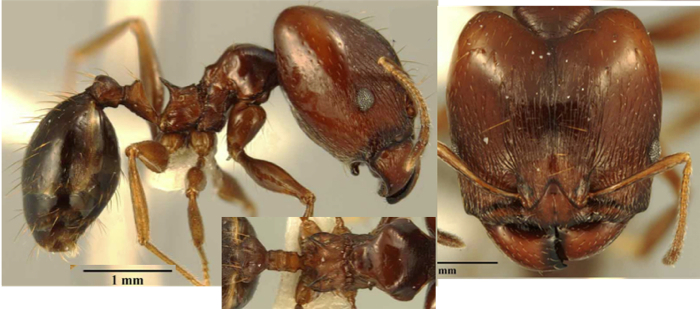
Major:
HL 1.90, HW 1.93, SL 0.96, PW 0.88; CI 102, SI 50; posterolateral
lobes smooth and shiny; face with weak and
relatively short rugae; dorsal promesonotum mostly smooth and shiny,
with superficial rugulae anteriorly |
. |
|
| . |

HL
0.78, HW 0.75, SL 0.89, PW 0.48; head
almost as wide as long (CI 94–98), posterior margin not convex, but
almost straight; scapes and mandibles shorter (SI 114–121,
MDI 69–73) |
Ghana,
Ivory Coast - rebeccae |
| F
9A |

Major: HL 1.97, HW 2.02, SL 1.02, PW 0.88; CI 102, SI
51; scape and metatibia
pilosity fine and inconspicuous, mostly
fully appressed (Fig. 10B); long standing hairs absent on promesonotum
|
. |
|
| . |

HL 0.85,
HW 0.78, SL 1.02, PW 0.51; long
or moderately long hairs completely absent on alitrunk and waist
segments; petiole and postpetiole without laterally projecting hairs in
dorsal view; metatibia pilosity appressed; second mesonotal process and
sculpture on propodeum reduced; metanotal groove wide in profile;
spines long (PSLI 33)
|
Cameroun,
CAR, Gabon - glabrella |
|
| F 9B |
Major: scape and metatibia
pilosity conspicuous and decumbent; standing hairs often present on
promesonotum
Minor: Moderately long hairs at least present on waist segments,
sometimes also on promesonotum; on petiole and/or postpetiole some
laterally projecting hairs in dorsal view; metatibia pilosity
decumbent; second mesonotal process and sculpture on propodeum not
reduced; metanotal groove relatively narrow in profile; spines slightly
shorter (PSLI 29).
|
F 10
|
|
| F 10A |
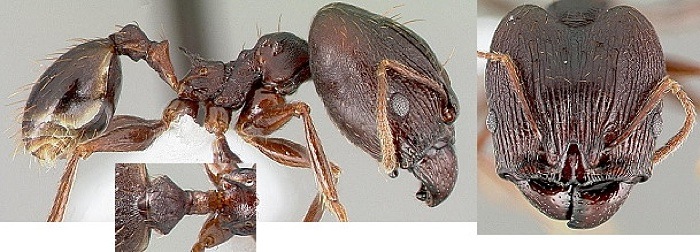
Major:
TL
4.0-4.5 mm, HL 1.87, HW 1.87, SL 1.04, PW 0.83; CI 100, SI 56; deep
piceous,
almost black; propodeal spines long and slightly downcurved
posterolateral
lobes of head longitudinally rugose,
with spaces between rugae weakly to superficially punctate; second
mesonotal process at same level as dorsopropodeum. |
. |
|
|

HL
0.85, HW 0.76, SL 1.07, PW 0.49; posterior
head margin roundly convex; face and dorsal promesonotum mostly
superficially punctate to punctate; second mesonotal process not raised
above the level of dorsopropodeum; postpetiole relatively
short (PpLI 155–223). |
Congo
Basin east to Tanzania & Uganda - dea |
|
| F
10B |
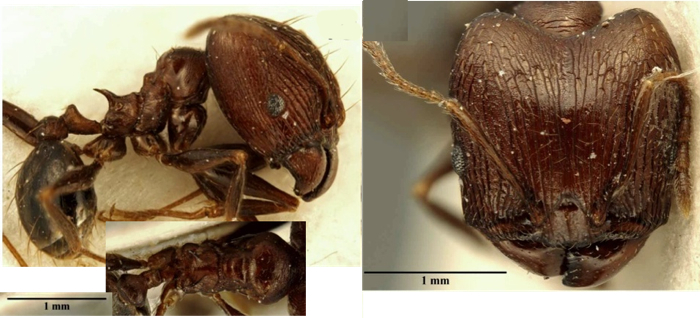
Major:
HL 1.80,
HW 1,76, SL 0.98, PW 0.80; CI 98, SI 56; separated more readily from
differences in the minor workers. The
major workers of semidea
possess an irregular pattern of longitudinal rugae on the frons, joined
by a few cross-meshes on the vertex and oblique rugulose-punctate
sculpture on the posterolateral lobes versus regular longitudinal rugae
from frons to vertex in dea.
They also have a higher situated second mesonotal process and, on
average, a slightly longer and wider postpetiole; posterolateral
lobes of head punctate, overlain by oblique and
superficial rugulae; in lateral view second mesonotal
process raised above level of dorsopropodeum.
|
.
|
|
| . |

HL 0.80, HW
0.70, SL 0.99, PW 0.48; posterior
head margin weakly convex, with small median impression; face and
promesonotum smooth and shiny, with very few superficial punctures; in
lateral view second mesonotal process distinctly raised above the level
of dorsopropodeum; postpetiole relatively longer (PpLI
126–167).
|
Nigeria
- semidea
|
|
|
 Top of page Top of page
|
|
|